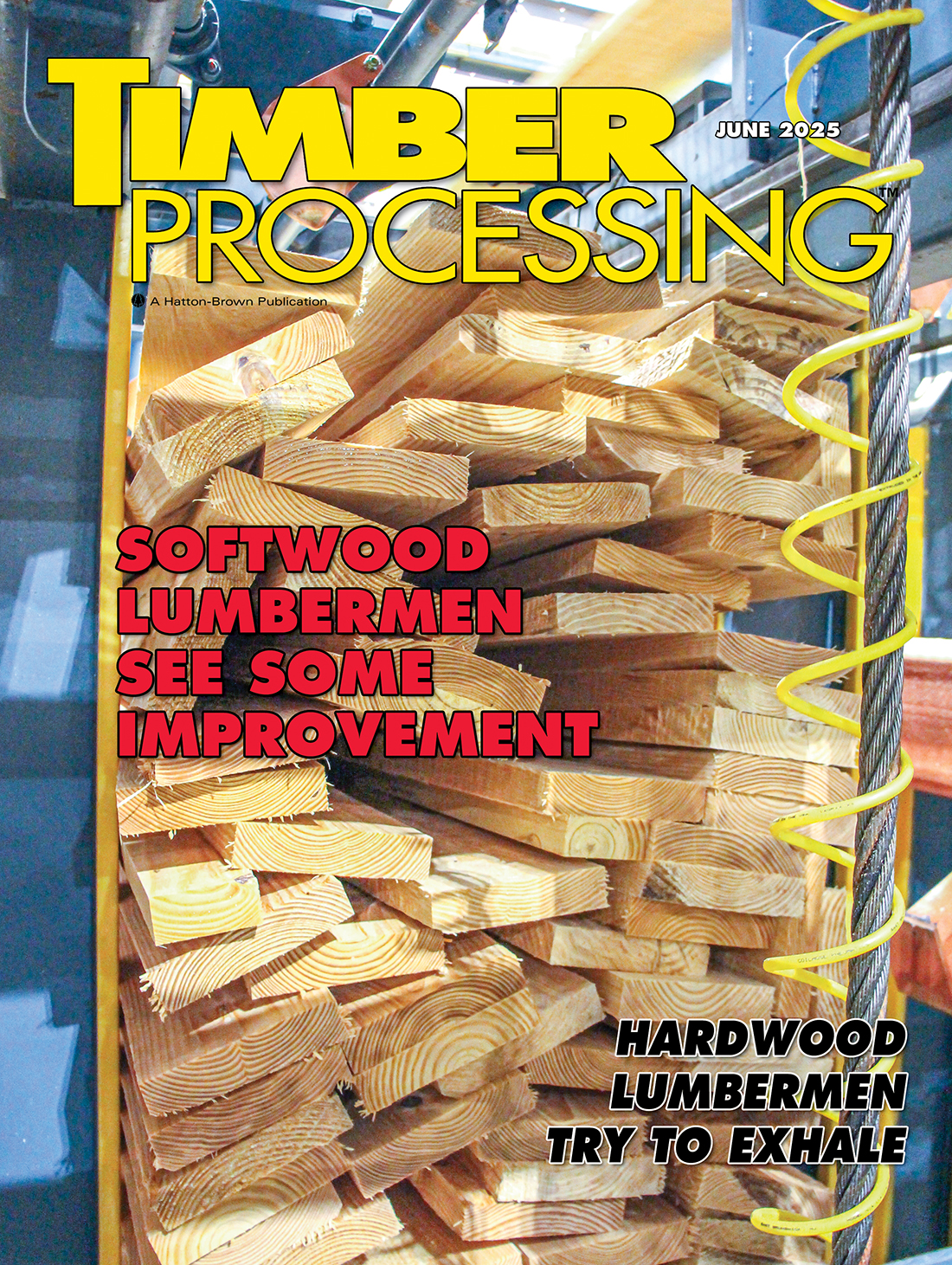Inside This Issue
NEWSfeed
- Weyerhaeuser Tops Timberlands List
- Duysen Always Stepped Up
- PFI Leads Fly-In To Congress
THE ISSUES: No Jumping For Joy, But It's Picking Up
Hard to believe a year has passed since we did our 2024 Annual U.S. Sawmill Operations & Capital Expenditure survey results story. But a year it indeed has been, and this issue provides the results of the 2025 survey.
COVER: Some Better
There’s some light at the end of the tunnel for U.S. softwood lumberman.
U.S. softwood lumbermen may not be bursting at the seams with optimism, but only several month since the swearing-in of a new president they are in a better place than they were a year ago, according to the results of Timber Processing’s Annual U.S. Sawmill Operations & Capital Expenditure Survey.
Article by Rich Donnell, Editor-in-Chief, Timber Processing
Hardwood Lumber Survey
U.S. hardwood lumbermen are feeling “less bad” than they were a year ago about their lumber business situation, according to Timber Processing’s annual U.S. Sawmill Operations & Capital Expenditure Survey.
Asked to forecast their lumber business situation for 2025-2026, 28% of the hardwood lumbermen said it will be poor, while 54% said “fair” and 18% said good (14%) or excellent (4%). A year ago 36% landed in the poor category and 45% were forecasting “fair,” with the remaining 19% anticipating “good” and zero pointing to excellent.
MACHINERY Row
- Minda Acquires Fingerjoint Specialist
- Rosboro Converts To UniFlow Kilns
- Carbonizer Creates Organic Carbon
- Biolube Names Sales Manager For Northwest
AT Large
- SFPA Announces 2024 Safety Leaders
Find Us On Social
The Issues: No Jumping For Joy, But It’s Picking Up
Article by Rich Donnell, Editor-in-Chief, Timber Processing
Hard to believe a year has passed since we did our 2024 Annual U.S. Sawmill Operations & Capital Expenditure survey results story. But a year it indeed has been, and this issue provides the results of the 2025 survey.
As usual we break down the results into separate stories on the softwood lumber and hardwood lumber industries. Ownership and managerial representatives from 160 softwood sawmills and 40 hardwood sawmills responded, and some offered extremely valuable insights, some of which we quoted in those stories.
Softwood and hardwood lumber producers each have their own personality traits, so to speak, one being that the hardwooders are usually a good bit less positive than their counterparts. But in this space we like to provide some of the combined results to provide a glimpse of the overall U.S. lumber production industry.
The most important question of the survey asked the lumbermen what they forecasted for their lumber business situation for the remainder of 2025 and 2026. About 4% said excellent and 31% said good, while 53% said fair, 11% said poor and 1% said very poor.
Just for the sake of comparison, a year ago in the survey a mere 1% said excellent and 24% said good, while 39% said fair, 29% said poor and 7% said very poor.
So as you can see, there’s a slight lifting of the spirits since a year ago for some of the lumbermen.
But it is a far cry from the high tide of the post-pandemic era, when 46% forecasted 2021-2022 as excellent, 46% said good, 5% said fair, 0% said poor and 3% said very poor. Wow, the glory days were not so long ago.
Of course capital expenditure is a major thrust of the survey. About 32% of the respondents said their mills planned to spend at least $1 million during 2025-2026, with dollar amounts ranging to much higher in the millions. A year ago that “at least $1 million” number was 26%. But occasionally a comment made in the survey will pop up and cause us to groan, like this one: “No capital improvements due to sawmill being closed.” Bummer.
The survey tossed in a question on the tariffs policy of the new presidential administration, but the question most interesting to me asked the lumbermen that if given a reliable and consistent access to more timber sales on national forests as ordered by the president, would they consider building a sawmill or increasing production at their existing mills? 25% said maybe and 15% said yes, while 43% said no, while 15% said it didn’t really apply because of their location, and 2% hadn’t heard of the executive order.
A special thanks goes to those who took some time to complete the survey. And to those who weren’t able to, there’s always next year.
Want More Content?
Timber Processing magazine is delivered 11 times per year to subscribers, who represent sawmill ownership, management and supervisory personnel and corporate executives.
Newsletter
The monthly Timber Processing Industry Newsletter reaches over 4,000 mill owners and supervisors.
Subscribe/Renew
Timber Processing is delivered 10 times per year to subscribers who represent sawmill ownership, management and supervisory personnel and corporate executives. Subscriptions are FREE to qualified individuals.
Advertise
Complete the online form so we can direct you to the appropriate Sales Representative.

